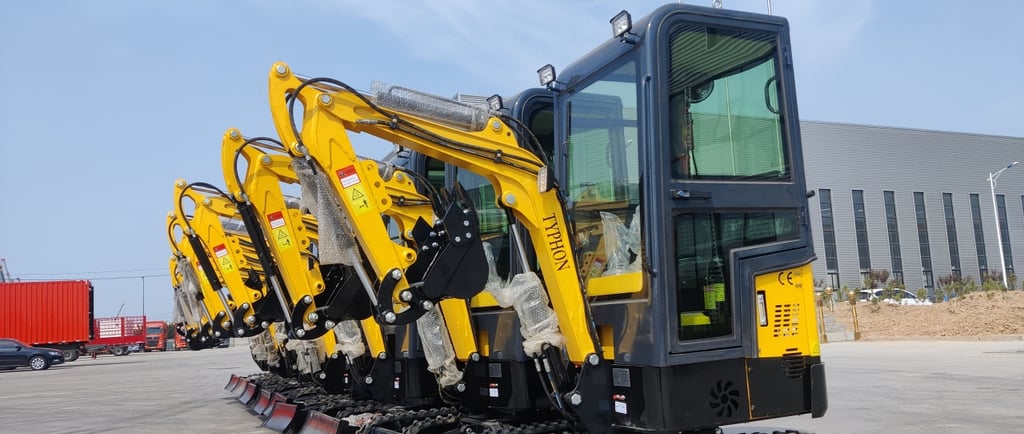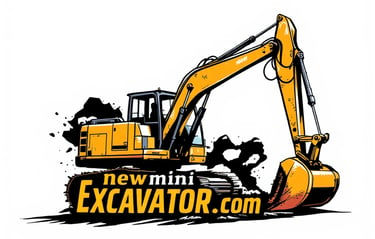Understanding and Addressing Mini Excavator Final Drive Motor Issues and Failures
9/27/20247 min read


Introduction to the Final Drive Motor
The final drive motor is an integral component of the mini excavator's drive system, responsible for providing the essential power transfer that propels the machine's tracks. At its core, the final drive motor operates in conjunction with the hydraulic motor to convert hydraulic energy into mechanical energy, ensuring that the excavator can move smoothly and effectively across various terrains. This intricate process begins as the hydraulic motor generates hydraulic pressure, which is then converted by the final drive motor into torque that turns the tracks.
Understanding the function of the final drive motor is crucial for appreciating its contribution to the overall performance of the mini excavator. A well-maintained final drive motor ensures optimal power distribution, which is essential for executing power-intensive tasks such as excavation, trenching, and digging. By efficiently transmitting high torque, the final drive motor facilitates precise and robust operations, allowing the machine to handle heavy loads and tough ground conditions with ease.
Moreover, the final drive motor plays a pivotal role in enhancing the mini excavator's efficiency. A functioning final drive motor ensures that the hydraulic power generated is utilized effectively, minimizing energy waste and promoting smoother operations. This efficiency not only contributes to prolonged operational periods without overheating but also extends the overall lifespan of the mini excavator by reducing wear and tear on other components.
In essence, the key benefits of a well-functioning final drive motor revolve around increased torque, enhanced performance, and improved energy efficiency. By ensuring that the final drive motor operates at peak levels, operators can rely on their mini excavators to perform demanding tasks with precision and reliability, which is fundamental for maximizing productivity on job sites. Recognizing and addressing any issues with the final drive motor promptly is thus imperative to maintain the operational integrity and effectiveness of mini excavators.
```html
Common Signs of a Faulty Final Drive Motor
Identifying the common signs of a malfunctioning final drive motor in a mini excavator can prevent costly repairs and extended downtime. A vital component of these machines, the final drive motor is crucial for translating hydraulic power into mechanical movement, thereby ensuring the efficient operation of the excavator. A failing final drive motor often exhibits several distinct symptoms, which need immediate attention.
One of the most noticeable signs is the presence of unusual noises. These can range from grinding to knocking sounds, which typically suggest internal component wear or bearing failure within the motor. Such noises indicate that the motor is struggling to perform its intended function smoothly and can lead to complete motor seizure if not addressed promptly.
Reduced power is another critical symptom. If the mini excavator seems less responsive or struggles to achieve its usual speed or torque, the final drive motor could be the culprit. This lack of power may stem from hydraulic inefficiencies or mechanical blockages within the motor, leading to a significant drop in performance. Operators should not ignore these signs, as they often precede more severe breakdowns.
Difficulty in maneuvering or turning the machine is also a red flag. Any unusual resistance felt while steering indicates potential issues within the motor, such as compromised gears or hydraulic flow disruptions. Smooth and responsive movement is essential for the precise operation of the mini excavator, and any deviation from this norm warrants a thorough inspection.
Lastly, oil leaks originating from the motor area signify possible seal failures. Hydraulic oil is essential for the proper functioning of the final drive motor, and leaks not only decrease its efficiency but can also lead to further internal damage. Ensuring that these leaks are promptly fixed is crucial to maintaining the excavator's health.
Addressing these warning signs early is paramount. Catching and rectifying issues in the final drive motor at the initial stage helps prevent extensive damage and ensures the longevity and efficiency of your mini excavator.
```
Investigating Final Drive Motor Problems
When it comes to mini excavators, early identification of final drive motor issues is crucial for preventing further damage and ensuring the longevity of the machinery. If operators notice signs such as unusual noises, reduced performance, or leaks, it is essential to stop using the machine immediately to prevent exacerbating the problem.
To begin investigating potential issues, the first step involves a thorough visual inspection. Operators should meticulously examine the final drive motor and surrounding components for any visible signs of leaks, wear, or damage. It is important to check for oil spots or pooled fluids, as these usually indicate cracks or compromised seals. Additionally, inspect the hoses and connections for any signs of deterioration or disconnection.
Once the visual inspection is complete, using diagnostic tools can significantly aid in assessing the condition of the final drive motor. Tools such as infrared thermometers can measure the motor's operating temperature, highlighting potential overheating issues. Similarly, hydraulic pressure gauges can assess the motor's performance by gauging the system's pressure levels and identifying anomalies.
Throughout this process, it is essential to consult the mini excavator’s manual. The manual provides specific troubleshooting steps, safety guidelines, and maintenance schedules tailored to the machine’s model and make. By adhering to the manufacturer's recommendations, operators can ensure that they are investigating the final drive motor correctly and safely.
In situations where the issue is not easily identifiable or if the investigation reveals serious damage, seeking professional assistance is highly advised. Certified technicians have the expertise and specialized equipment to diagnose and repair final drive motor issues efficiently. Engaging a professional can not only save time but also prevent further damage, ensuring that the mini excavator remains in optimal working condition.
Regular maintenance and prompt attention to potential final drive motor issues can significantly enhance the durability and performance of mini excavators, ultimately reducing downtime and repair costs.
Causes of Final Drive Motor Failures
Final drive motor failures in mini excavators can be attributed to several prevalent causes, each influencing the machine's overall performance. Among the most significant factors is poor maintenance. Neglecting regular maintenance schedules, such as not changing hydraulic fluid or ignoring manufacturer guidelines, can lead to the accelerated degradation of the motor. Without proper upkeep, the components of the final drive motor can suffer from deterioration due to persistent wear and tear.
Contamination of hydraulic fluid is another critical issue. Hydraulic fluid contamination, caused by dirt, moisture, or metal particles, can severely impair the functionality of the motor. Contaminants act as abrasive materials, inducing excessive wear on the motor’s internal components, which in turn leads to operational failure. This contamination often results from inadequate filtration or exposure to unclean environments, emphasizing the importance of maintaining a clean hydraulic system.
Overloading the machine also plays a crucial role in final drive motor failures. Mini excavators are designed to handle specific loads, and exceeding these limits can cause undue stress on the motor. Overloading forces the motor to operate beyond its capacity, leading to overheating and accelerated wear. Consistent overloading can result in catastrophic failures, necessitating costly repairs or replacement of the final drive motor.
Additionally, wear and tear over time is an inevitable factor that contributes to motor failure. Even with meticulous maintenance, the components of the final drive motor experience natural degradation. Bearings, gears, and seals can wear out, reducing the efficiency and functionality of the motor. This gradual wear and tear underscore the importance of routine inspections and timely replacement of worn parts to prevent unexpected failures.
Understanding these causes is essential for addressing and preventing final drive motor issues. By implementing proper maintenance practices, ensuring clean hydraulic fluids, avoiding overloading, and monitoring component wear, the longevity and performance of mini excavators can be significantly enhanced.
Preventative Maintenance Tips
Preventative maintenance plays a crucial role in mitigating potential final drive motor issues in mini excavators. Implementing a structured maintenance routine not only prolongs the lifespan of the motor but also ensures that the machine operates at optimal performance.
One fundamental aspect of preventative maintenance is conducting routine inspections. Regularly check for any signs of wear, leaks, or unusual noises emanating from the final drive motor. Early detection of anomalies can prevent minor issues from escalating into major failures, saving both time and money.
Ensuring the cleanliness of the hydraulic fluid is paramount. Contaminated hydraulic fluid can cause excessive wear and tear on the motor components. Regularly monitor and replace the hydraulic fluid as prescribed by the manufacturer. Utilizing high-quality hydraulic fluid and filters can further enhance the motor’s longevity and performance.
Adhering to the mini excavator’s load capacity is equally important. Overloading the machine can exert undue stress on the final drive motor, leading to premature failure. Always operate the mini excavator within its designated load limits, and refrain from using it for tasks beyond its intended capacity.
Scheduling periodic professional check-ups is another vital preventative maintenance practice. Expert technicians can conduct thorough inspections, identify potential issues, and perform necessary adjustments or repairs. These professional evaluations complement routine inspections and provide a comprehensive assessment of the final drive motor’s condition.
Moreover, keeping the mini excavator clean, especially around the final drive components, can prevent the buildup of dirt and debris, which can obstruct the motor’s normal operation. Regular cleaning routines can thus contribute significantly to maintaining the motor's efficiency.
Incorporating these preventative maintenance strategies not only enhances the reliability of the final drive motor but also extends the overall lifespan of the mini excavator, ensuring that it remains a dependable asset for various construction and excavation tasks.
Conclusion and Best Practices
Recognizing and addressing final drive motor issues promptly is crucial for maintaining the efficiency and longevity of mini excavators. This blog post has covered the various symptoms and causes of final drive motor failures, emphasizing the significance of early detection and regular maintenance. It is clear that a proactive approach can prevent costly repairs and downtime.
Operators should be vigilant in monitoring their equipment for any signs of trouble, such as unusual noises, slow movement, or visible leaks. Regularly scheduled inspections and maintenance checks are indispensable in identifying potential issues before they escalate. Key practices include keeping the drive motor clean, ensuring proper lubrication, and routinely checking for any signs of wear or damage.
Adhering to the manufacturer's guidelines for servicing and using high-quality parts and fluids can significantly enhance the performance and durability of the final drive motor. Additionally, being mindful of the workload and operating conditions can prevent unnecessary strain on the motor, further extending its lifespan.
Operators are encouraged to adopt these best practices, remaining vigilant for any indications of malfunction. Regular maintenance not only preserves the machinery's operational efficiency but also optimizes safety and productivity on the job site.
In conclusion, by staying attentive to their mini excavators' final drive motors and performing diligent upkeep, operators can ensure their equipment remains in peak condition. Implementing the tips and practices outlined in this blog will undoubtedly contribute to the effective and reliable performance of their machinery.
Explore our wide range of mini excavators for sale.
Company
© 2024. New Digger for sale, All rights reserved.


Privacy Policy | Terms and Conditions
Follow us now
Support
For Inquiries
2522 S Malt Ave. Commerce, CA 90040
United States
Our Location
Tel:
+1-213214 2203
WhatsAp:
+1-3235325703
Mon-Fri: 9am-5pm
